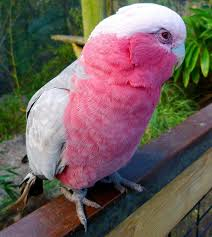Rose-Breasted Cockatoo

Description
The rose-breasted cockatoo (Eolophus roseicapilla), also known as the galah /ɡəˈlɑː/, galah cockatoo, roseate cockatoo or pink and grey, is one of the most common and widespread cockatoos, and it can be found in open country in almost all parts of mainland Australia.
It is endemic on the mainland and was introduced to Tasmania, where its distinctive pink and grey plumage and its bold and loud behaviour make it a familiar sight in the bush and increasingly in urban areas. It appears to have benefited from the change in the landscape since European colonisation and may be replacing the Major Mitchell's cockatoo in parts of its range.
The term galah is derived from gilaa, a word found in Yuwaalaraay and neighbouring Aboriginal languages.
Galahs are about 35 cm (14 in) long and weigh 270–350 g. They have a pale silver to mid-grey back, a pale grey rump, a pink face and chest, and a light pink mobile crest. They have a bone-coloured beak, and the bare skin of the eye rings is carunculated. They have grey legs. The sexes appear similar, however generally adult birds differ in the colour of the irises; the male has very dark brown (almost black) irises and the female has mid-brown or red irises. The colours of the juveniles are duller than the adults. Juveniles have greyish chests, crowns, and crests, and they have brown irises and whitish bare eye rings, which are not carunculated.
Scientific Name
Eolophus Roseicapillus
Country Of Origin
Australia
Size
Life Expectancy
Noise Level
Loud
Talk / Trick Ability
Moderate
Characteristics
An endless performer, the rose-breasted cockatoo thrives on interaction from its human flock and a plethora of toys while on its own. To keep rose-breasted cockatoos happy, they need at least one hour of playtime a day. They also exercise time with their owner and several more hours of supervised out of the cage time.
Behavior / Health Concerns
Without enough mental and physical stimulation, rose-breasted cockatoos can resort to destructive behaviors, such as feather picking. They are susceptible to psittacine beak and feather disease (PBFD), fatty liver disease, obesity and bumblefoot. While these pet birds need attention and time with humans, they must also learn how to be independent and not become accustomed to an excessive amount of human attention. Rose-breasted cockatoos can become territorial once they have matured and they are often destructive chewers. These pet birds are known to be dusty birds, and which is a concern for those with allergies.
Expert Advice
“In my experience, rosies are quite different from most of the white cockatoos and can be compared in some ways to the African grey. They will suffer if raised in less than optimal rearing conditions, and can develop very fearful behavior at times if stability in the environment isn’t present in their early years.”
Pamela Clark, IAABC Certified Parrot Behavior Consultant